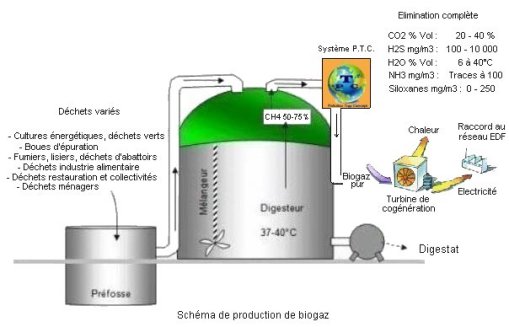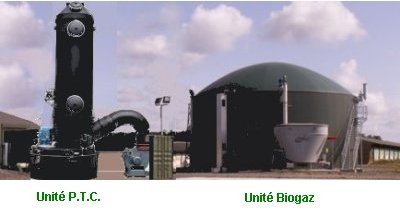Le
Portail de l'innovation
|
|
P.T.C.
System
and Bio-energies
Concentrations of CO2, the main greenhouse gas, continue
to rise. The symbolic threshold of 400 ppm has just been
crossed, bringing us dangerously close to the climatic
tipping point of the Earth.
Each
m3 of biogas from methanisation has helped to avoid the
release into the atmosphere of 2.3 kg of
carbon dioxid (CO2) responsible for global warming.
However,
it must be borne in mind that each m3 of biogas produced
always contains between 20 and 40% CO2, ie between 3 kg
and 6 kg, which are ultimately released to the atmosphere,
either during purification in biomethane by the
or in the use of biogas without purification.
|

The
GASWASH process participates in the fight
against CO2 emissions
|
A
methanisation unit of 2 MW electrical, by the principle
of methanization, thus avoids the emission of about 9 000
t of CO2 in the atmosphere.
It should be noted that this same methanisation unit of
2 MW and which consumed about 4 Mm3 of biogas nevertheless
emitted between 800 and 1600 t of CO2 in the atmosphere
depending on the nature of the methanated substances. |
| |
|


|
The
recovery of biogas
Composed mainly of methane and carbon dioxide, biogas
is efficiently recovered in biomethane
by purification processes.
This
technique, called methanisation, is caused in digesters,
during the treatment of household refuse, industrial or
agricultural waste and sewage
sludge.
Biogas, resulting from the fermentation of this waste,
is a renewable energy source which, after purification,
can replace natural gas of fossil origin.
Farmers, industrialists and communities thus treat their
waste while exploiting their energy and economic potential.
The GASWASH purification solution enables the recovery
of all biogas for injection into the natural gas network,
the production of vehicle fuel (biomethane gas or liquid)
or the production of renewable hydrogen after biomethane
reforming.
The
purification technology using the GASWASH technique
In order to transform biogas into a substitute for natural
gas, it is necessary to get rid of all the pollutants.
The GASWASH process proposes a technical solution that
allows biogas producers to efficiently use biomethane
in its process of purification.
The technology used makes it possible to permanently remove
carbon dioxide (recyclable CO2), and to eliminate in the
same operation N2, O2, H2O, H2S, NH3, Siloxanes,
Organochlorines or Organofluorines.
The
hydrogen sector, starting from methanisation, should
logically find its place in the near future.
ttp://www.innovalor.fr/biogaz-biomethane.htm
|
|
|

Example
of implementation of the GASWASH process on a methanation
unit
|
|
In the field of sustainable development, the GASWASH process
is particularly well adapted technically and economically
to the products of natural hydraulic fracturing for the
extraction of Biogas and their purification in Biomethane.
Hydrofractioning should not be confused with natural
hydraulic fracturing (cryoclasty) that results,
on the surface, from the effect of the freeze-thaw cycle
of water trapped in a rock and the erosion of the soil
by water- Water to supply silts, sediments, alluviums
and vases in which the organic matter accumulates in large
quantities and gives a sapropel (black mud) or lignite
(debris of woody matter)..
|
|
|
This "Fracking"
sector has never been valued.
|
The
GASWASH
process is integrated in the field of Sustainable Development
for the reduction of greenhouse gases and the upgrading
of renewable energies. The purification of the biogas with
the GASWASH process makes
it possible to obtain directly pure biomethane in one operation
"One-pot" process and the VABHYOGAZ process is the process
for obtaining "fuel cell" quality Bio-Hydrogen.
All
these two complementary technologies allow the lowest cost
of manufacture of Bio-H2.
The
GASWASH process
is the only known technology to date, making it possible
to permanently eliminate and recover advantageously the
CO2 resulting from methanation in the form of carbonates
and which are recoverable in particular in industry.
It
allows the total, sustainable and one-time capture of CO2
as well as all the volatile polluting compounds (N2, O2,
H2O, H2S, NH3, Siloxanes, Organochlorines or Organofluorines).
The
GASWASH technology allows a cost of production of biomethane
3 times cheaper than the competition and thus makes it possible
to reduce the cost difference between the methane of fossil
origin and the biomethane to incorporate it in the gas distribution
network.
With the VABHYOGAZ
process, biomethane purified with the GASWASH process.
Will provide biofuel quality "fuel cell" at a hydrogen selling
price well below the famous threshold set at
13 € / kg.
On the other hand, the GASWASH process technology allows
an extremely simple biogas purification equipment whose
investment cost is inconsistent with the existing processes.
|
|
|
Show
more on GASWASH
|
|
Quelquefois,
les plus petits ressorts font mouvoir les plus grandes machines.
(Jean-Paul Marat)


Pour
nous écrire
|
![]() Valorisation
Valorisation